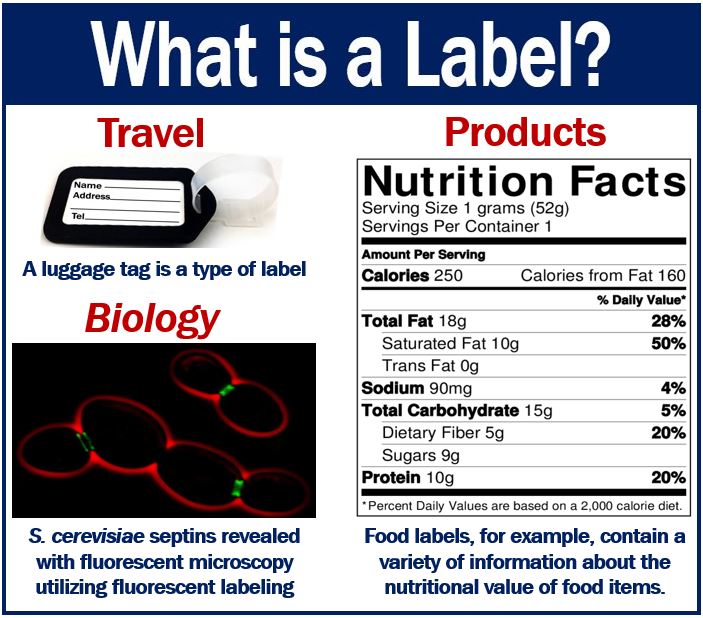What is a label? Definition and examples
The term Label may refer to a small piece of fabric, paper, or plastic that is attached to a product. It has information about that product. For example, clothes companies attached labels to garments. The labels have information about the garments’ materials, size, and the company that made them.
The term may also refer to a classifying name or phrase that we apply to somebody. We may apply that phrase or name to something as well. In most cases, the classification is inaccurate. Somebody might say, for example, “In fact, I don’t really care about labels – conservative or liberal.”
The verb ‘to label’
As a verb, the word may mean to attach/affix something, such as a tag or sticker. Somebody may, for example, label a series of parcels and write the receivers’ addresses on them.
In biology, it means to make something, such as a molecule, identifiable by replacing an atom with another one that has a distinctive radioactive isotope. For example, a scientist might label insulin with iodine-125, which acts as a tracer.
Business Dictionary has the following definition of the term:
“Pictorial, descriptive, or informative matter (such as a brand, mark, or tag), attached, embossed, impressed, marked, printed, or stenciled on (or otherwise forming a part of) a product and/or its container.”

Etymology of label
Etymology is the study of the history of words and how their meanings evolved.
The term emerged in the English language in the thirteenth century with the meaning “strip of cloth or narrow band.” It was initially a technical term in heraldry. It came from the Old French word Label, Lambel, Labeau, which meant “ribbon, fringe worn on clothes.”
In the early fifteenth century, the word acquired the meanings “dangling strip of cloth or ribbon used as an ornament in dress.” In that same century, it also began to mean “a strip attached to a document to hold a seal.”
It wasn’t until the 1670s that it also meant a “tag, sticker, slip of paper” that one affixed to something to indicate its contents, nature, etc.
In 1907, a label also came to mean a “circular piece of paper in the center of a gramophone record.” The paper contained information about the record. This led to the meaning “a record company” in 1947.
Label in business
In the world of business, a label is a piece of paper, plastic, cloth or metal. The manufacturer affixes it to a product or container.
In addition to providing information, labels can also serve as a marketing tool, using colors, fonts, and designs to attract consumers and communicate the brand’s identity and values.
Recent technological advancements have enabled the integration of digital elements into labels, such as QR codes, which can provide consumers with additional product information, interactive content, or even augmented reality experiences when scanned with a smartphone.
Labels have many possible uses. They may include information on the origin of a product, its manufacturer, shelf-life, and use. It may also have information on its disposal.
In most countries, food labels have to conform to legal requirements.
Hazardous products such as flammable liquids or poisons must have a warning label.
Food label
Food and beverage labels usually contain critical information on a product’s ingredients or contents. They may also call out to specific allergy risks such as a presence of peanuts, soy, or gluten.
In the United States, the FDA provides standards for regulating information on the labels and packages of wines and spirits. These labels include information such as alcohol content, class and type designation, and brand name.
FDA stands for Food and Drug Administration. The FDA is the US regulatory agency in charge of medical devices, foods, cosmetics, medications, and tobacco products.
Label – parts of speech
-
Noun
As a noun, a label is a piece of paper, fabric or other material that we attach to products.
Here are two examples:
“Lacoste has an easily recognizable label.”
“If it does not have a famous label, he won’t buy it.”
-
Verb
The term may also be a verb.
Here are two examples:
“My job at the grocery store involves labeling the products for easy identification.”
“Robots today automatically label Tommy Hilfiger clothes.”
-
Adjective
To make an adjective, we use the past participle of the verb ‘to label’, which is ‘labeled’ (British: labelled).
Here are two examples:
“She prefers clothes without any labeled tags,”
“Why aren’t these shirts labeled?”
-
Adverb
There is no adverb form directly derived from ‘label.’
Video – What is a Label?
This educational video, from our sister channel on YouTube – Marketing Business Network, explains what a ‘Label’ is using simple and easy-to-understand language and examples.

